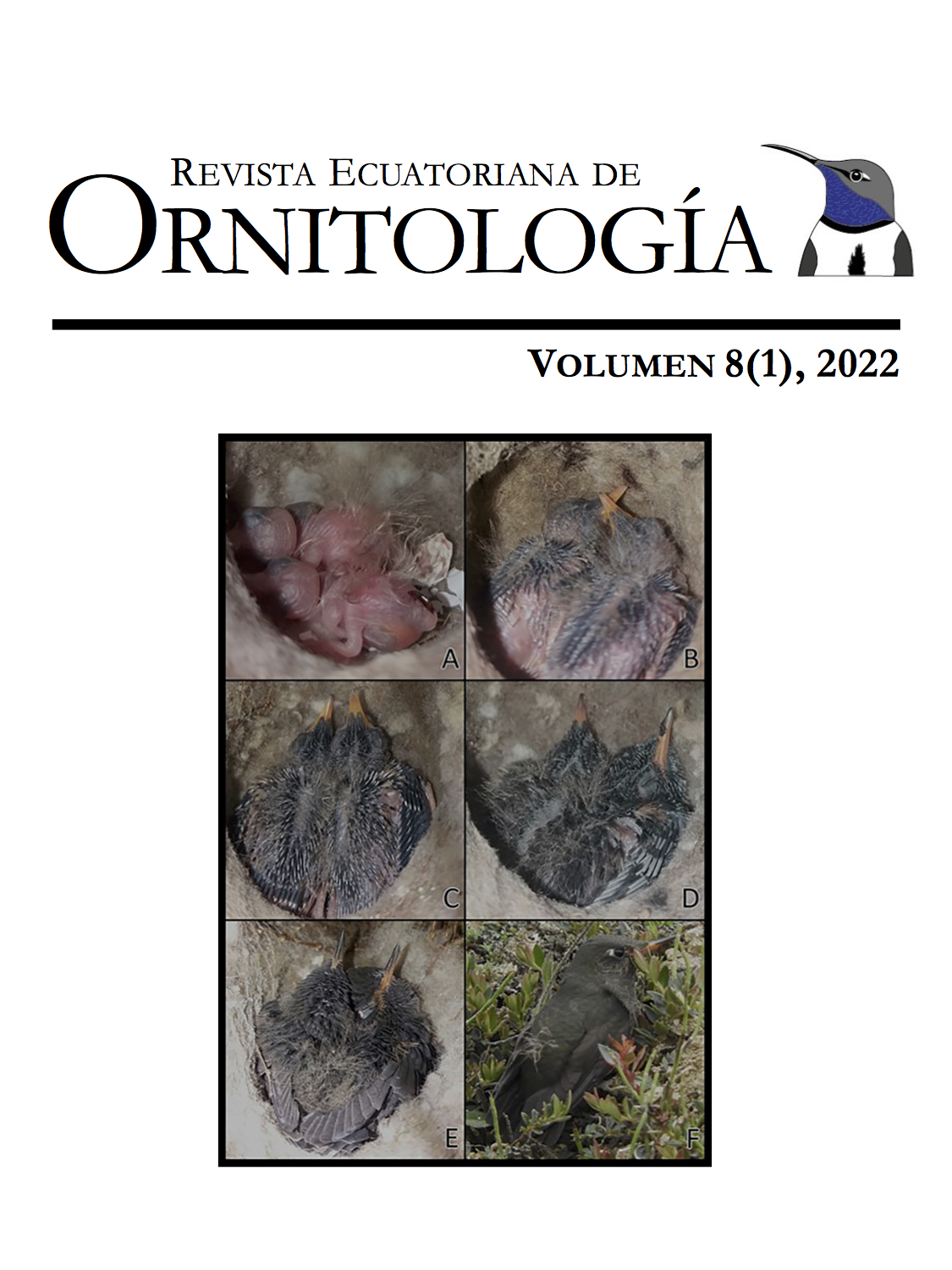NOTAS REPRODUCTIVAS DE COLACINTILLO COLINEGRO Lesbia victoriae (APODIFORMES: TROCHILIDAE) EN QUITO, ECUADOR
REPRODUCCIÓN DE Lesbia victoriae EN QUITO
DOI:
https://doi.org/10.18272/reo.v8i1.1808Abstract
Abstract. - I performed direct observations to seven Lesbia Victoriae"™s broods between the years of 2016 and 2020, in the garden of my residential complex in Quito. I monitored three nests, one of them had five consecutive broods. After courtship, females build the nests, then lay the eggs; the chicks are born naked and open their eyes after 17 days, the mother stays in the nest between 13 and 15 days, the female incubates the eggs from 18 to 19 days. The fledglings are ready to fly after 25 - 27 days and don"™t present sexual dimorphism. This study shows updated information on the reproductive biology of this hummingbird species in an urban environment.
Key Word. - nesting, city, hatching, incubation, nests, chicks
Downloads
References
Castro, L. A., Cuevas, J. S., Ortegón, D., Pulido, J. P., Torres, A. M., & Velásquez, M. (2017). Jardines verticales como alternativa para mejorar el estado de ánimo de la población de adultos en un centro gerontológico de la ciudad de Bogotá DC (Colombia). Revista de Tecnología, 16(1), 47-58. DOI: https://doi.org/10.18270/rt.v16i1.2315.
Fjeldså, J., & Krabbe, N. (1990). Birds of the high Andes. Copenhagen, Dinamarca: Zoological Museum, University of Copenhagen.
Freile, J. F., & Restall, R. (2018). Birds of Ecuador. Londres, Reino Unido: Helm.
Kiff, L. F., Marin, M., Sibley, F. C., Matheus, J. C., & Schmitt, N. J. (1989). Notes on the nests and eggs of some Ecuadorian birds. Bulletin of the British Ornithologists' Club, 109(1), 25-31. URL: https://www.biodiversitylibrary.org/item/123708#page/7/mode/1up
Moore, R.T. (1947). Habits of male hummingbirds near their nests. The Wilson Bulletin, 59(1), 21-25. URL: https://www.jstor.org/stable/4157541
Ortiz-Crespo, F. I. (2011). Los colibríes: historia natural de unas aves casi sobrenaturales, 2nd edición, Quito, Ecuador: Imprenta Mariscal.
Przybysz, A., Wińska-Krysiak, M., Małecka-Przybysz, M., Stankiewicz-Kosyl, M., Skwara, M., Kłos, A., Kowalczyk, S., Jarocka, K. & Sikorski, P. (2020). Urban wastelands: On the frontline between air pollution sources and residential areas. Science of The Total Environment, 721, 137695. DOI: https://doi.org/10.1016/j.scitotenv.2020.137695.
Züchner, T., Boesman, P. F. D., & Kirwan G. M. (2020). Black-tailed Trainbearer (Lesbia victoriae), version 1.0. In: J. del Hoyo, A. Elliott, J. Sargatal, D. A. Christie, E. de Juana (Eds.), Birds of the World. Ithaca, NY: Cornell Lab of Ornithology. DOI: https://doi.org/10.2173/bow.blttra1.01.
Downloads
Published
How to Cite
Issue
Section
License
Los autores que publiquen en la Revista Ecuatoriana de Ornitología aceptan los siguientes términos:
- Los autores/as conservarán sus derechos de autor y garantizarán a la revista el derecho de primera publicación de su obra, el cuál estará simultáneamente sujeto a la Licencia de Reconocimiento No Comercial de Creative Commons.
- Los autores/as podrán adoptar otros acuerdos de licencia no exclusiva de distribución de la versión de la obra publicada, pudiendo de esa forma publicarla en un volumen monográfico o reproducirla de otras formas, siempre que se indique la publicación inicial en esta revista.
- Se permite y se recomienda a los autores difundir su obra a través de Internet en su repositorio institucional, página web personal, o red social científica (como ResearchGate o Academia.edu).


